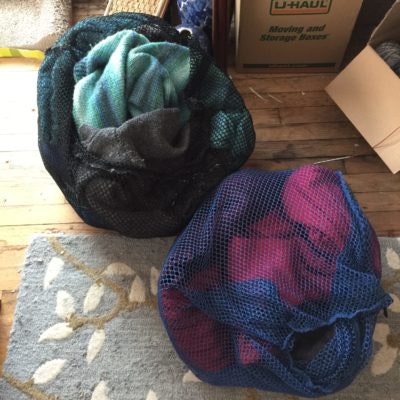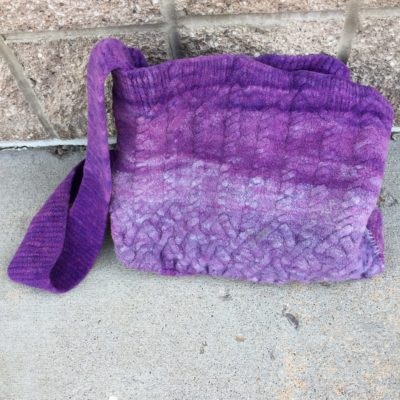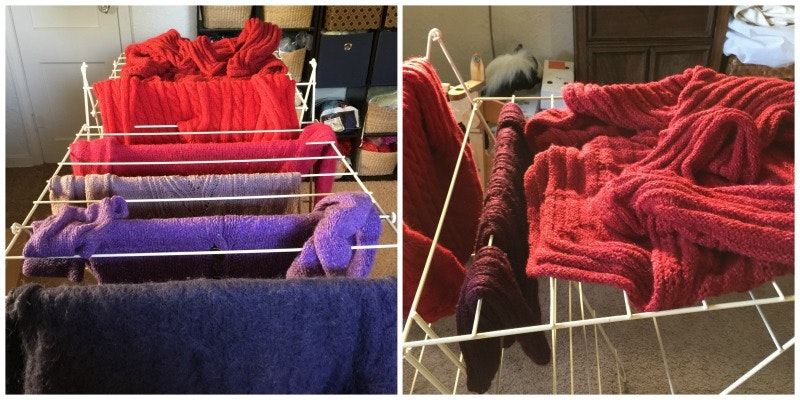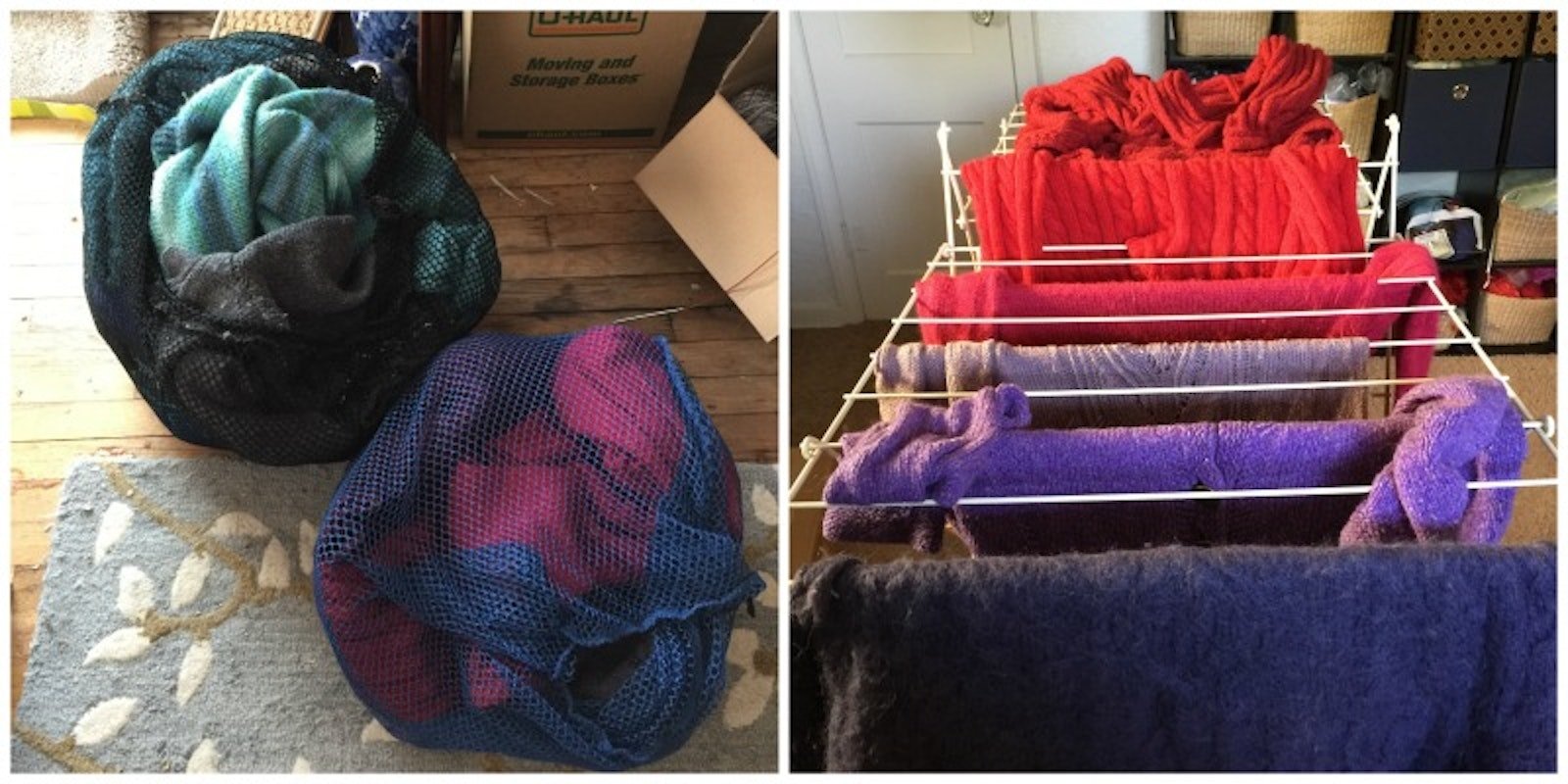When you’re eager to switch out your winter and summer wardrobes—and who isn’t?—it can be all too tempting to pack away your handknitted sweaters quickly, without giving them any special TLC. In my opinion, it’s too much work to wash them all by hand, one at a time. If they’re going to lie in boxes all summer, why not wait until autumn to wash everything? Won’t they get wrinkled or covered in dust if they’re crammed into boxes? What if you need to reblock or mend something? Believe me, I know all these excuses because, once upon a time, they were my excuses too. My closet contains an embarrassingly large number of handknitted sweaters, and since I wear them frequently, I also have to wash them frequently.
These intense laundry needs, combined with a dislike for conventional handwashing methods (and some unfortunate moth incidents), led me to some experiments that could preserve my beloved sweaters without extraordinary investments of time and energy (after all, I need those resources to knit more sweaters!). So I’ve perfected a laborsaving system for washing and storing seasonal knitwear. If you’ve ever wondered how to wash sweaters more efficiently, my “Lazy TLC” system may work for you as it has for me. Tweak as needed.
No Excuses
First, however, I want to address the excuses listed above, armed with advice from people who know wool: handspinners. Even if you don’t spin, it’s worth looking at Judith MacKenzie’s The Intentional Spinner or Kate Larson’s The Practical Spinner’s Guide: Wool for their chapters on caring for wool textiles.
If you pack up any woolens for long-term storage, take the time to wash them first. And I mean wash, not dry-clean. Wool has no objection to water; in fact, it loves water. Dry-cleaning chemicals and the dry-cleaning process itself can be hard on precious yarns, and clothing can get lost at the dry cleaners, etc.
While you don’t have to wash your sweaters after each wearing, they do need some cleaning now and again. Even when you wear other layers under them, sweaters will eventually absorb perspiration and oil from your skin, especially at underarms and neckband. These body fluids can discolor yarn over time. Lingering body aromas may even heighten wool’s attractions for undesirable wool-loving bugs or curious pets—they’re the beer goggles of the animal kingdom—while their unpleasant smell can simultaneously repel desirable humans. Make your wool happy before you pack it away for a few months, and remember that clean wool is happy wool.
Non-wool sweaters also need washing before they’re stored, as do store-bought sweaters. Fortunately, my program can work for all kinds of knitwear, no matter what yarn they’re made of or how many you have to launder. My secret weapon: the washing machine. Basically, I use the washer as a soaking tub and a water-removal device so that I can wash many sweaters in one batch.
Equipment
- Washing machine
- Lingerie bags (optional)
- No-rinse sweater soak
- Foldable clothes drying rack, gullwing or accordion style
- Storage containers, airtight if possible
- Garment steamer (optional)
Washing & Drying
1. Gather up a bunch of sweaters or other handknits that you want to wash. Mend anything that needs mending. Remove any buttons that can’t soak in water. Brush off dried mud, food, etc. (Remember that burrito explosion last week? That’s what I’m talking about.)
2. If there is any chance that colors could bleed when these garments get wet, sort them into dark and light groups, or color families, so you can wash all deep blues in one batch, all pale colors in another, and so on. I use a lot of hand-dyed yarns and dye my own, and even commercial yarns aren’t always completely colorfast. Do you really want to risk your cream-colored Aran sweater that took you 2 years to make? Unless you want it to turn pink, don’t throw a red sweater into the same bath with it.

My handknitted greens and reds, separated for separate sessions in the machine. If I leave them sitting for too long, the bags become cat beds.
3. Stock up on your favorite sweater soak, avoiding anything that needs to be rinsed out. I buy my favorite soak in a gallon jug, which will last for a few years.
4. Get to know your washing machine. This is vital! If you’ve got a fancy front-loader with digital settings instead of a manual dial, you may not be able to interrupt its wash cycle as described below. Instead, use a big sink, laundry tub, or bathtub for steps 5–7, then skip to step 9.
5. If your machine’s cycles can be interrupted, you’re in luck! Fill the washing machine with warm water, adjusting the water level as appropriate. I generally use the medium or large load setting.
6. Add the sweater soak and swish your hand through the water to distribute the soak throughout the tub. I typically use ¼ cup in the washer, unless the garments seem extra dirty.
7. Add the sweaters, gently pushing them down under the water. I generally wash 6 to 8 big sweaters at once, or 8 to 12 summer tees and tanks, at the medium load water setting. Again, plan ahead to minimize accidents: if you’re concerned about delicate items, zip them into lingerie bags first. In all my years of washing sweaters this way, I’ve never seen a cardigan’s buttons catch onto another sweater, but I can’t promise that it won’t happen.
8. Advance the machine’s cycle setting to the spin cycle or press whatever button turns off the machine, and let everything soak undisturbed for 20 to 30 minutes. DO NOT let the machine to go into agitation mode. Agitation mode can shrink or even felt your sweaters. Once a sweater shrinks or felts, it will never be the same. Trust me on this one—it’s why one of my handspun, hand-dyed sweaters with elaborate cables had to be recycled into a tote bag.

This tote bag used to be a handspun, hand-dyed, handknitted sweater. Then I accidentally let the machine go into agitation mode. While I love the bag, I miss the sweater more.
9. Run the spin cycle to remove all the water. It’s a faster and more efficient way to remove water (meaning your sweaters will dry faster) than wrapping the garments in towels.
10. I hang most of my sweaters on a drying rack. Don’t put them on hangers to dry: even after going through the spin cycle, the garments will still retain some water, and their heaviness can stretch them out of shape on a hanger. Gullwing and accordion-style racks can hold many sweaters at once if you hang them over separate bars. Even if you want to lay the sweaters flat for drying, you should be able to fit 3 sweaters on a gullwing rack at one time. Any sweater with dyed stripes or colorwork is safer laid flat to dry. Wet knitted fabric can stretch, and wet colors can bleed, so again, protect your precious knits from potential accidents.
11. Let the garments dry completely, which shouldn’t take more than 48 hours if you used the spin cycle in most environments. If you live in a humid location, a fan helps tremendously. They need to be bone-dry before you store them, especially if using airtight containers for storage.

Left: I hang knitted tees, tanks, and sweaters over separate bars, without letting them touch each other. Right: Knitted coats and jackets are too large and heavy for such treatment, so I lay them across several bars at once.
Storing
Now you’re ready to box up clean, dry garments. What sorts of containers work best? While some handspinners recommend storing fiber in airtight plastic buckets, sweaters don’t really require such careful treatment unless you’re worried about rodents or wool-chomping insects. Over the years, I’ve used plastic bins and decorative boxes with tight-fitting (but not airtight) lids, sized to fit closet shelves, the space under my bed, and so on. Do get containers with lids to keep everything clean and secure. Puppies and rabbits love to chew; cats love boxes and sweaters, so the combination could prove irresistible. Many pets shed, and while their fur can add a one-of-a-kind look to your handknits, it might not be the one-of-a-kind look you enjoy. If you’re going to store knitwear for more than a few months, I would avoid sealed plastic bags (which can trap moisture) and open baskets or bins. Seriously, lids are your friends.
Store packed boxes of knitwear in places that won’t be affected by dampness, moisture, direct sunlight, or unwanted visitors from the animal kingdom. All of these things can damage knitwear.
Protecting
Dampness & moisture: Most of us can’t store our handknits in a room perfectly controlled for humidity and temperature. If you live in a humid region, or have to store your knits in a humid part of the house, you could add packets of desiccants to storage boxes. Buy these packets at craft stores or save all those little packets that come in shoeboxes.
Pests: Rodents, carpet beetles, and certain moths love to nest in wool. The bugs’ larvae eat unclean wool, then grow up to produce more offspring to eat your wool. Mice like soft, dark, safe beds for themselves and their babies. Prevent infestations by making your stored sweaters unavailable (in airtight bins of heavy plastic) or unrecognizable. Moths smell wool, so mask the scent with lavender or aromatic cedar. Set out pheromone traps so that you can recognize an infestation at its earliest signs. If the worst happens, handspinners know all the best ways to stop a moth invasion. (Their advice also applies to yarn and fiber stashes as well as finished projects.)
My handspinning resources all warn that it’s much easier to prevent problems than to try fixing them after the fact. They recommend checking storage bins and storage areas for signs of damage or infestation; vacuuming or otherwise cleaning storage areas; immediately quarantining infested yarn/fiber/knitwear to contain the situation. In other words, constant vigilance!
Out of Storage
When the seasons change, unpack your knits and check (again) for signs of damage. If you need to remove wrinkles or generally freshen them up, use your garment steamer. You shouldn’t need to wash these garments again unless something malodorous happened inside the storage containers. (I’ll leave this part to your imagination.)
A closing note: never forget that Mother Nature works by contraries. The day after you wash and store all your warm sweaters, expect a freak snowstorm. A heat wave will occur right after you pack away light summer knits, as surely as night follows day. Fortunately, you should have plenty of clean, appropriate knits ready to rock and roll, no matter what the weather holds!
Deb Gerish is the former editor of Love of Knitting Magazine.
Originally published May 25, 2017; updated November 19, 2021; updated September 5, 2022.

